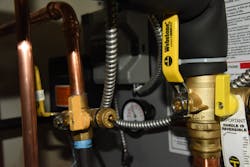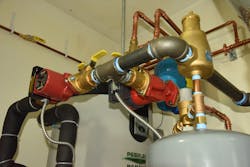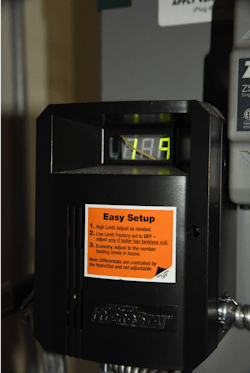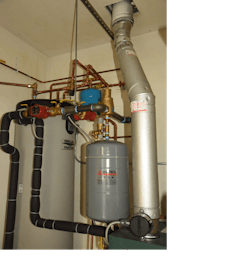Cast Iron: When, Where, and Why?
by Rich Bruno, Licensed Master Plumber
The internet has changed every aspect of the way we live. More and more people are doing their shopping on the internet. Need shampoo? Order on-line. Need laundry detergent? Order on-line.
How does it affect the HVAC and plumbing industry? Years ago, if Mr. and Mrs. Jones needed a boiler they called their local plumber, we went to their home, hopefully did a IBR heat loss, made our recommendations, gave an estimate and hopefully did the job.
Now Mr. and Mrs. Jones call and when you go visit they have all the research done. They watched all the home improvement shows, they did their internet research, they heard the government is giving rebates on high efficiency equipment and they are ready to do business. People ask me all the time: “What equipment should I purchase?” My answer is always the same: “Buy whatever equipment your HVAC or Plumbing professional recommends and has training on installation and service and has repair parts if it breaks down Sunday at midnight.” When you have to wait three days for parts in the middle of the winter it’s not good for business. Back in the 80’s a 24 volt gas valve, a thermocouple, some miscellaneous safety devices on my truck and there wasn’t many situations where I couldn’t give you heat. Now with proprietary parts it’s a new ballgame.
Let’s get back to Mr. and Mrs. Jones. They did their research and are ready to buy. They want brand XYZ boiler and you are familiar with brand ABC. You went to ABC’s training class, the rep is a good guy and your local supply house has replacement parts, you even have some basic parts on your truck. This is where you MUST sell them ABC boiler or if they won’t change from XYZ it may be wise to walk away. If you’re installing the XYZ and you have a problem, do you know who to call? Are repair parts readily available? Are you and ALL of your technicians trained? A good salesman will know how to sell his product. There is nothing wrong with XYZ, but you are doing your customer an injustice by getting involved. I can guarantee you that in more than fifty percent of these situations you will be asking yourself, “Why did I take this job?”
Now let’s discuss what I see as a bigger problem, using condensing equipment when it will never condense. My buddy Mike just bought a 27-year-old house. He’s concerned with the 27-year-old water heater and asked me to put in one of those new small things he’s seen on TV. He has two bathrooms and maybe 50 feet of baseboard. If I go this route I will be hanging a very expensive 85% efficient boiler on the wall. Condensation is what makes these boilers work. The condensation washing over the heat exchanger is what keeps them clean. If they don’t condense they don’t work as designed and I guarantee within two years there will be problems.
I have two options here:
Option 1: An on-demand wall mounted water heater.
Pros: Efficiency
Possible Utility rebate.
Cons: May need larger gas line.
Venting may be an issue.
Long payback.
Option 2: An indirect storage tank added to the existing boiler.
Outdoor reset control to existing boiler.
Pros: Less material cost.
Faster payback.
Possible utility rebate.
Most storage tanks come with limited lifetime warranty.
There are some situations where a free standing cast iron pin boiler is still the correct choice. There are still some issues I have to deal with. I have to re-pipe the heating zone, which I would have to do with a condensing boiler, it’s a builder’s install, no valves—if you’ve been around you get the idea. I may even change the boiler after doing a heat loss.I will take out the inefficient tank water heater, I’m going to add outdoor reset and cut the energy bill by probably 20 percent. The payback will be 1/3rd of the time that it would take for installing a condensing combi system or instantaneous water heater.
Well, after doing a heat loss calculation I had a net heat loss of 66,000 BTU’s. I use the IBR method to do a heat loss. Most boiler manufacturers have some type of program to help you with this, but no matter how you do it, do a heat loss survey before you proceed. Since the existing boiler was a 100,000 BTU cast iron boiler I figured it would be wise to change out the boiler. Other issues that made the decision easy was the existing installation. The boiler was on a combustible floor and appliance connectors were used to supply gas to the existing boiler and water heater.
Now to choose the equipment. I wanted efficiency, simplicity, easy access to replacement parts and American-made when possible. The boiler chosen was a Peerless MI-04 with a net IBR rating 0f 77,000 BTU’s. The boiler was supplied with a Hydrolevel Hydrostat which uses a built in logarithm or an optional outdoor reset control to adjust water temperature on days where outdoor temperature is above the outdoor design temperature used in the heat loss calculations.
For the Indirect water heater I chose a Peerless PT 60. A 40 gallon storage tank would have handled the houses domestic needs but to get the maximum output I would have had to put in a much larger boiler. The correct way to size the boiler is size it for the heating load and increase the tank size to compensate.
Some codes are now requiring water heaters and storage tanks run at maximum temperature and a tempering valve be used to safely set water temperature delivered to faucets.
Every manufacturer is offering a full line of press fittings so I choose a Calleffi tempering valve and a Calleffi boiler trim kit. I love their trim kits, everything in one box and my favorite feature is the check valve in the expansion tank that allows for service and replacement without draining the system. I have seen some installations where a valve was placed between the air scoop and the expansion tank! This is a dangerous practice that should be avoided.
The completed project:
For the rest of the parts and pieces needed to finish the project I used Webstone valves. I was able to isolate the circulators with Webstone Isolator uni-flange ball valves for future service and the Webstone Ball Drain valve allowed me to isolate and purge each zone with a minimum of fittings.
You may notice that the first fitting in the relief valves are compression fittings. I’ve been on many jobs where the installer ran copper pipe and fittings on the outlet side of the relief valves. On a weekend or night call the last thing anyone wants to do is get a torch out to replace a relief valve. When installing a boiler make sure you think of the guy that has to service it.
Richard Bruno has 45 years of experience in the plumbing and heating industries and is a licensed Master Plumber in Nassau and Suffolk Counties, New York. He has owned and operated his own company, is a licensed instructor in NY State and has held sales management and trianing positions with Centrotherm Eco Systems, Bacharach, Sid Harvey, Crown Boiler, Carlin and SlantFin. He is the author of The Residential Guide to Gas Heating and has trained countless technicians throughout the United States and Canada.



